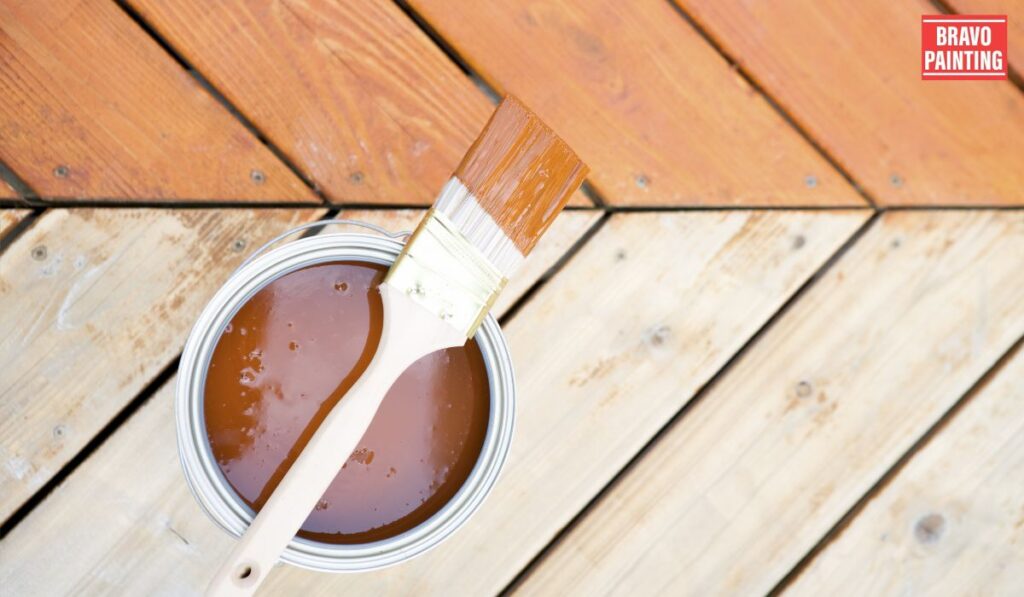Deck and porch staining is essential to maintaining the beauty and longevity of outdoor wooden structures. Whether you’re a seasoned DIY enthusiast or a first-time Stainer, these tips and tricks will help you achieve a professional-looking finish. This article covers common questions about deck and porch staining, provides helpful information to ensure a successful project, and offers valuable insights to enhance your staining technique.
Common Questions About Deck and Porch Staining
What is the most efficient way to stain a deck?
Staining a deck efficiently requires careful planning and execution. The best approach involves dividing the deck into manageable sections and working on one team at a time. Start by thoroughly cleaning the deck and allowing it to dry completely. Use a high-quality stain applicator, such as a brush or roller, and apply the stain following the wood grain. Work methodically, ensuring even coverage and avoiding overlap marks.
Is it better to brush or roll stains on a deck?
Both brushing and rolling can be effective methods for applying deck stain, but the choice depends on personal preference and the specific characteristics of your deck. Brushing allows for better control and penetration into the wood, especially in rough or intricate areas. Rolling, on the other hand, is faster and more suitable for more extensive, flat surfaces. For optimal results, consider using a combination of both techniques. Start with a brush for detailed work, then switch to a roller for broader areas.
What happens if you don’t clean your deck before staining?
Failing to clean your deck before staining can result in an uneven and unsatisfactory finish. Dirt, debris, and mildew can prevent the stain from adequately adhering to the wood, leading to premature peeling and discoloration. Cleaning your deck before staining removes these contaminants, allowing the color to penetrate the wood and bond effectively. Invest time thoroughly cleaning your deck, using appropriate cleaners and techniques, to achieve the best results.
What do you need to know before staining a deck?
Before diving into your deck staining project, there are a few crucial aspects to consider. Firstly, check the weather forecast and choose when to expect dry weather for at least 48 hours after staining. Ensure the deck is structurally sound and free from any rot or damage. Additionally, familiarize yourself with the type of wood your deck is made of, as different wood species may require specific stains or preparation methods.
Helpful Tips for Deck and Porch Staining

Keep an eye on the forecast.
Weather conditions play a crucial role in the success of your deck staining project. Staining should ideally be done when the temperature is between 50°F and 90°F, with moderate humidity. Avoid staining during rainy or scorching and sunny days, as these conditions can affect the drying and absorption of the stain. Check the forecast beforehand and plan your staining project accordingly.
Make sure to prep the surface.
Proper preparation is vital to achieving a flawless deck stain. Start by removing furniture, plants, or other items from the deck. Sweep away debris, leaves, and dirt, and then proceed with a thorough cleaning. Use a deck cleaner or mild detergent solution to remove mold, mildew, or stains. Rinse the deck thoroughly and allow it to dry completely before applying the color. Sanding may be required to smooth rough areas or remove old stains.
It’s all about the brushes.
Choosing the right brushes can significantly impact the outcome of your staining project. Use high-quality brushes designed explicitly for deck staining, as they are durable and provide excellent coverage. Consider using a broad brush or a stain applicator pad for larger areas. If you opt for a roller, select one with a medium nap suitable for the texture of your deck. Remember to clean the brushes thoroughly after each use to prolong their lifespan.
Match the stain to your wood type.
Different wood species have unique characteristics and require compatible stains. Before purchasing a deck stain, identify the type of wood your deck is made of. Hardwoods like cedar or redwood typically benefit from semi-transparent stains, which enhance the natural beauty of the wood while providing protection. Softwoods, such as pine or fir, may require more durable and pigmented colors for better protection against the elements. Consult a stain professional or refer to the manufacturer’s guidelines for optimal selection.
Take it easy and apply thin coats.
When it comes to applying deck stain, less is often more. Using thin coats allows the paint to penetrate the wood and ensures even coverage. Avoid overloading the brush or roller with pigment, as it can lead to puddling and uneven distribution. Apply the stain with smooth and consistent strokes, following the wood grain. If you desire a darker or more intense color, apply additional thin coats after the first one has dried.
FAQs
Q: How often should I stain my deck or porch?
A: Staining frequency depends on several factors, including the type of wood, climate conditions, and the level of foot traffic. As a general guideline, it is recommended to stain your deck or porch every 2-3 years for optimal protection and appearance.
Q: What is the best time of year to stain my deck or porch?
A: The ideal time to stain your deck or porch is during mild weather conditions when temperatures range between 50°F and 90°F. Avoid staining during periods of high humidity, rain, or extreme heat.
Q: Can I stain my deck or porch or hire a professional?
A: Staining a deck or porch can be a DIY project, provided you have the necessary tools, time, and patience. However, hiring a professional can ensure a high-quality result if you need more clarification or have a large and complex project.
Q: What are the steps involved in staining a deck or porch?
A: The steps involved in staining a deck or porch include cleaning the surface, allowing it to dry, applying the stain with brushes or rollers, and allowing sufficient drying time between coats. Proper preparation, including sanding and removing old paints, may sometimes be necessary.

Q: How long does a deck or porch stain take to dry?
A: The drying time for deck or porch stain depends on various factors, such as temperature, humidity, and the type of stain used. Generally, colors can take a few hours to a couple of days to dry completely.
Q: Can I apply a new coat of stain over an existing color?
A: Applying a new coat of stain over an existing paint is possible if the previous color is in good condition and adequately adhered to the wood. However, ensuring the new stain is compatible with the old one is crucial to avoid any compatibility issues or undesirable results.
Q: How do I prepare my deck or porch before staining?
A: Preparing your deck or porch before staining involves removing furniture and other items, sweeping away debris, and cleaning the surface with a deck cleaner or mild detergent solution. Sanding may be necessary to smooth rough areas or remove old stains.
Q: What stain should I use for my deck or porch?
A: The type of stain you should use depends on the wood species and your desired outcome. Semi-transparent stains enhance the natural beauty of the wood, while solid or opaque paints provide more coverage and protection. Consult with a stain professional or refer to the manufacturer’s guidelines for the best selection.
Q: How do I choose my deck or porch stain color?
A: Choosing the right color for your deck or porch stain depends on personal preference and the overall aesthetic you wish to achieve. Consider the existing color palette of your home and outdoor surroundings, as well as the natural tones of the wood. Testing samples on a small, inconspicuous area can help you visualize the final result.
Q: When staining my deck or porch, how do I protect nearby plants and furniture?
A: Covering nearby plants and furniture with plastic sheets or tarps can protect them from accidental stain splatters. Secure the coverings properly to prevent them from shifting or blowing away during staining.
Q: What are some common mistakes to avoid when staining a deck or porch?
A: Some common mistakes to avoid when staining a deck or porch include overloading the brush or roller with stain, applying too thick of a coat, not allowing sufficient drying time between coats, and neglecting proper surface preparation. Following the instructions provided by the stain manufacturer and practicing patience will help you achieve the best results.
Q: How do I maintain and care for a stained deck or porch?
A: To maintain a stained deck or porch, regularly sweep away debris, clean the surface as needed, and inspect for any signs of wear or damage. Depending on the type of stain used, periodic reapplication may be necessary. Avoid using harsh chemicals or abrasive cleaning tools that could damage the tint.
Q: Can I use a pressure washer to clean my deck or porch before staining?
A: While pressure washers can be effective for cleaning decks, they should be used cautiously. High-pressure settings or improper techniques can damage the wood fibers and affect the stain’s adhesion. If using a pressure washer, follow the manufacturer’s instructions and use a fan tip nozzle at a safe distance from the wood.
Q: What are some signs that my deck or porch needs to be restained?
A: Faded or discolored areas, loss of water repellency, or signs of wood damage are indications that your deck or porch may need to be restained. A water droplet test can help determine if the wood is absorbing water correctly or if it’s time for a new coat of stain.
Q: How can I remove old stains from my deck or porch?
A: Removing old stains from a deck or porch usually involves using a stain stripper or sanding and scraping. Follow the manufacturer’s instructions when using a stain stripper and take appropriate safety precautions. Sanding can help remove stubborn or peeling stain layers.
Q: Can I stain a deck or porch that has been previously painted?
A: Staining over a previously painted deck or porch can be challenging, as the paint can hinder the stain’s absorption and adhesion. It’s recommended to remove the paint entirely through sanding or stripping before applying a new color.
Q: What is the average lifespan of a deck or porch stain?
A: The average lifespan of a deck or porch stain varies depending on factors such as climate, exposure to sunlight, foot traffic, and the quality of the paint. Generally, colors can last between 2-5 years before requiring reapplication.
Q: How can I prevent the peeling or flaking of a deck or porch stain?
A: To prevent peeling or flaking of a deck or porch stains, ensure proper surface preparation, including cleaning and sanding if necessary. Avoid applying paints in direct sunlight or on a hot surface. Applying thin coats and allowing sufficient drying time between coats can also help prevent issues.
Q: Is it necessary to seal or waterproof a stained deck or porch?
A: Sealing or waterproofing may not be necessary depending on the type of stain used, as many colors already protect against moisture. However, applying a clear sealer or waterproofing product can be beneficial if you desire additional water repellency or a glossy finish.
Q: Can I stain a deck or porch treated with wood preservatives?
A: Staining a deck or porch treated with wood preservatives is possible, but ensuring compatibility between the preservative and the stain is crucial. Some preservatives may contain oils or additives that can interfere with the stain’s performance. Test a small area or consult a stain professional to ensure compatibility before proceeding.
Conclusion
Deck and porch staining can be a rewarding endeavor that enhances the aesthetics of your outdoor living space and protects the wood from the elements. Following the tips and tricks outlined in this article will enable you to tackle your next staining project confidently. Remember to plan, prepare the surface properly, choose the right brushes and stains, and apply thin coats for the best results. Happy staining!
DIY Home Improvements

